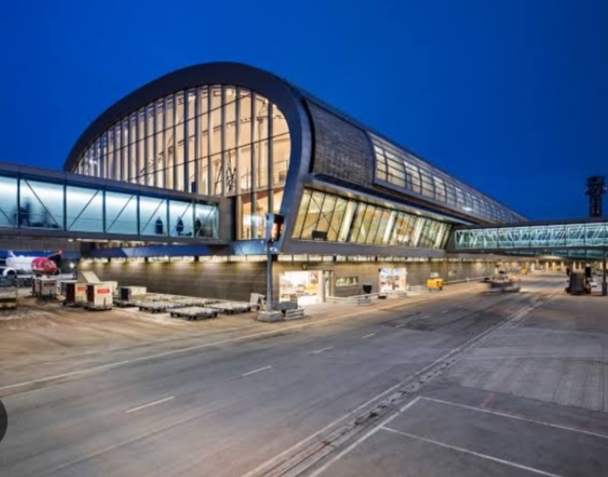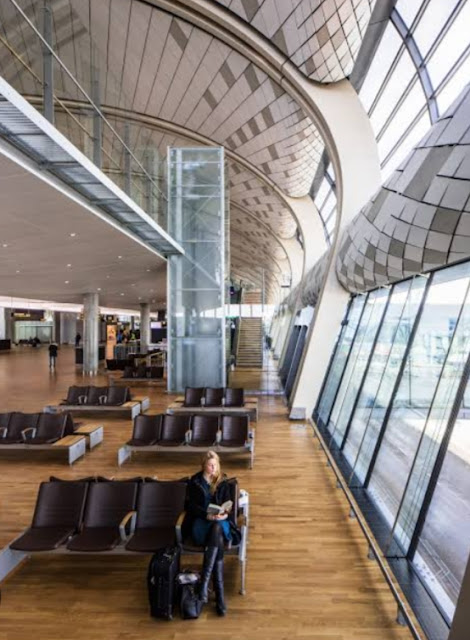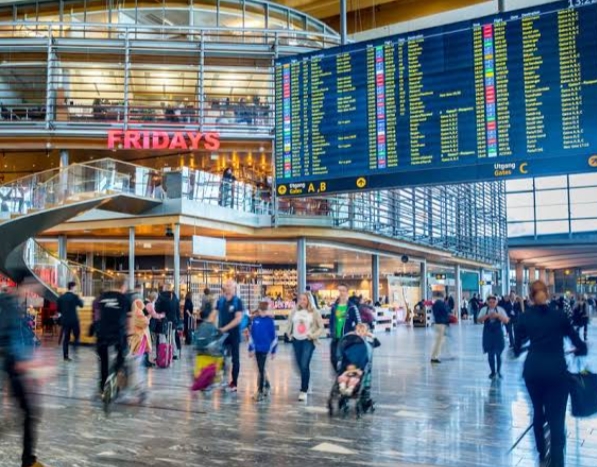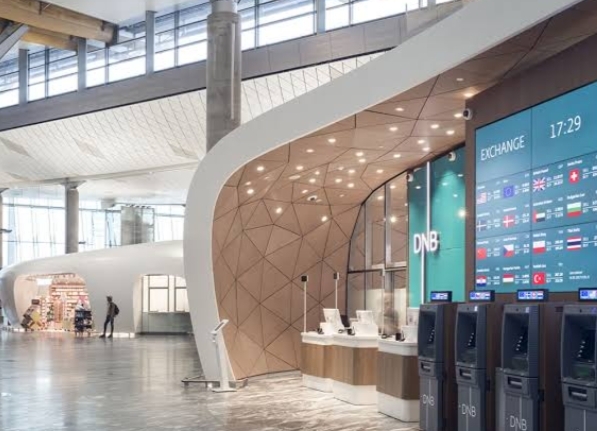Introduction Exploring Sustainability in Oslo Gardermoen Airport, Norway
Oslo Gardermoen Airport, located in Norway, has embraced sustainability initiatives to minimize its environmental impact.
The airport focuses on energy efficiency, waste reduction, and carbon footprint reduction. Through eco-friendly practices, such as renewable energy sources and waste recycling programs, Oslo Gardermoen strives to create a more sustainable and environmentally conscious travel hub.
These efforts align with Norway’s broader commitment to environmental stewardship and contribute to the global push for greener aviation.
Key of Sustainability in Oslo Gardermoen Airport, Norway
1. Renewable Energy: Oslo Gardermoen Airport emphasizes the use of renewable energy sources, such as wind and solar power, to reduce its reliance on conventional energy and minimize carbon emissions.
2. Energy Efficiency: The airport implements energy-efficient technologies and practices, including energy-efficient lighting, heating, and cooling systems, to optimize energy consumption and decrease its environmental footprint.
3. Waste Management: A robust waste management system is in place, focusing on recycling and minimizing landfill waste. Oslo Gardermoen Airport encourages passengers and businesses within the airport premises to participate in recycling programs.
4. Green Building Design: Sustainable building practices are incorporated into the airport’s infrastructure, with an emphasis on eco-friendly materials, efficient insulation, and innovative architectural designs to enhance energy efficiency.
5. Carbon Offsetting: The airport may participate in carbon offset programs to compensate for its unavoidable carbon emissions. This involves investing in projects that reduce or capture an equivalent amount of greenhouse gases elsewhere.
6. Public Transportation Access: Oslo Gardermoen promotes public transportation options, providing convenient access to buses, trains, and other sustainable modes of transit. This encourages travelers and airport staff to choose eco-friendly commuting alternatives.
7. Biodiversity Preservation: Efforts are made to protect and enhance the surrounding natural environment. This may include landscaping with native vegetation, preserving green spaces, and implementing measures to protect local wildlife.
8. Water Conservation: The airport likely adopts water-saving technologies and practices, such as efficient irrigation systems and water recycling, to minimize water usage and support sustainable water management.
These key sustainability measures showcase Oslo Gardermoen Airport’s commitment to environmental responsibility and contribute to Norway’s broader goals in promoting a greener and more sustainable future.
Renewable Energy Initiatives in Oslo Gardermoen Airport, Norway
Oslo Gardermoen Airport has implemented several renewable energy initiatives to reduce its carbon footprint and promote sustainable practices.
Some notable initiatives include:
1. Solar Power: Installation of solar panels across the airport infrastructure to harness energy from the sun, generating clean electricity and reducing dependency on traditional power sources.
2. Wind Energy: Integration of wind turbines in and around the airport premises to capitalize on wind power. This renewable energy source contributes to the airport’s overall energy mix, emphasizing sustainability.
3. Geothermal Systems: Utilization of geothermal energy for heating and cooling purposes. Geothermal systems tap into the Earth’s natural heat, providing an energy-efficient solution for maintaining comfortable temperatures within the airport facilities.
4. Energy-Efficient Lighting: Implementation of energy-efficient lighting solutions, such as LED technology, throughout the airport. This not only reduces energy consumption but also extends the lifespan of lighting fixtures, minimizing waste.
5. Partnerships with Renewable Energy Providers: Collaborations with renewable energy providers to source a significant portion of the airport’s energy from clean and sustainable sources. This may involve purchasing renewable energy credits or directly contracting with green energy suppliers.
6. Energy Management Systems: Adoption of advanced energy management systems to monitor and optimize energy usage in real-time. These systems help identify areas for improvement and enhance overall energy efficiency.
7. Sustainable Infrastructure Design: Incorporation of sustainable design principles in new construction and renovation projects. This includes the use of energy-efficient materials and architectural strategies that maximize natural light and ventilation.
8. Bioenergy Solutions: Exploration of bioenergy options, such as biomass or biogas, to diversify the renewable energy portfolio. These sources can be derived from organic waste and contribute to a more circular and sustainable approach.
By combining these renewable energy initiatives, Oslo Gardermoen Airport demonstrates a comprehensive commitment to environmental sustainability and plays a role in advancing Norway’s broader objectives for a greener and more resilient future.
Energy Efficiency Projects in Oslo Gardermoen Airport, Norway
Oslo Gardermoen Airport has implemented various energy efficiency projects to enhance its operational sustainability.
Some notable initiatives include:
1. Efficient Lighting Systems: Replacement of traditional lighting with energy-efficient LED fixtures, reducing overall energy consumption while providing better illumination.
2. Smart Building Management Systems: Adoption of advanced building management systems that optimize heating, ventilation, and air conditioning (HVAC) systems based on real-time occupancy and environmental conditions, leading to energy savings.
3. Energy-Efficient HVAC Systems: Installation of modern and energy-efficient heating, ventilation, and air conditioning systems to regulate indoor climate conditions while minimizing energy use.
4. High-Efficiency Equipment: Utilization of energy-efficient appliances and equipment throughout the airport facilities, from office spaces to baggage handling systems, to reduce electricity demand.
5. Thermal Insulation: Implementation of effective thermal insulation in buildings and infrastructure to reduce heat loss or gain, improving overall energy efficiency in temperature control.
6. Energy Recovery Systems: Integration of energy recovery systems in ventilation systems to capture and reuse heat energy, enhancing the efficiency of the airport’s heating and cooling processes.
7. Occupancy Sensors and Timers: Installation of occupancy sensors and timers for lighting, allowing lights to be automatically turned off in unoccupied areas or during periods of low activity.
8. Collaboration with Airlines and Ground Services: Engaging with airlines and ground service providers to optimize aircraft ground operations, minimizing unnecessary energy consumption during boarding, maintenance, and other ground activities.
9. Regular Energy Audits: Conducting periodic energy audits to identify areas for improvement and ensure ongoing energy efficiency. This may involve assessing equipment performance, monitoring energy usage patterns, and implementing corrective measures.
10. Employee Awareness Programs: Implementing educational programs to raise awareness among airport staff about energy conservation practices, encouraging a culture of sustainability throughout the organization.
These energy efficiency projects collectively contribute to Oslo Gardermoen Airport’s commitment to reducing its environmental impact and align with global efforts to create more sustainable and eco-friendly aviation practices.
Waste Management Systems in Oslo Gardermoen Airport, Norway
Oslo Gardermoen Airport has implemented comprehensive waste management systems to minimize environmental impact and promote sustainable practices.
Key components of its waste management approach include:
1. Waste Segregation: Implementation of a robust waste segregation system, encouraging separation of waste into categories such as recyclables, non-recyclables, and organic waste. This facilitates effective recycling and reduces the amount of waste sent to landfills.
2. Recycling Programs: Provision of recycling bins and containers throughout the airport for passengers and staff to easily dispose of recyclable materials like paper, plastic, glass, and metal. These materials are then sent to recycling facilities for processing.
3. Composting Facilities: Management of organic waste through composting facilities. Food scraps and other organic materials are processed into nutrient-rich compost, diverting them from landfills and contributing to soil enrichment.
4. Waste-to-Energy Initiatives: Exploration of waste-to-energy technologies where non-recyclable waste is used to generate energy. This approach helps reduce the volume of waste in landfills and contributes to the airport’s energy sustainability goals.
5. Reducing Single-Use Plastics: Implementation of measures to minimize the use of single-use plastics within the airport premises. This may include promoting reusable alternatives and encouraging concessions and shops to adopt sustainable packaging practices.
6. Partnerships with Waste Management Companies: Collaboration with waste management companies to ensure proper disposal and recycling of waste. This may involve working with local service providers to enhance the efficiency of waste collection and recycling processes.
7. Educational Campaigns: Conducting educational campaigns and awareness programs for passengers, airport staff, and businesses within the airport to promote responsible waste disposal and recycling practices.
8. Waste Audits: Regular waste audits to assess the composition and volume of generated waste, identify areas for improvement, and refine waste management strategies accordingly.
9. Circular Economy Initiatives: Exploring circular economy principles, such as product lifecycle management and material reuse, to minimize waste generation and promote a more sustainable approach to resource utilization.
By integrating these waste management systems and initiatives, Oslo Gardermoen Airport contributes to the reduction of its ecological footprint and aligns with Norway’s broader goals of achieving a circular and sustainable economy.
Green Building Design in Oslo Gardermoen Airport
Oslo Gardermoen Airport incorporates green building design principles to enhance sustainability and minimize environmental impact.
Key elements of its green building initiatives include:
1. Energy-Efficient Architecture: Integration of energy-efficient building designs that optimize natural lighting and ventilation, reducing the need for artificial lighting and HVAC systems.
2. Use of Sustainable Materials: Selection of eco-friendly and sustainable building materials with low environmental impact. This includes materials with recycled content, responsibly sourced wood, and products with minimal emissions.
3. Green Roof Technology: Incorporation of green roofs, featuring vegetation and planting, to improve insulation, reduce heat absorption, and promote biodiversity. Green roofs also assist in stormwater management by absorbing rainwater.
4. Water Conservation Measures: Implementation of water-saving technologies such as efficient irrigation systems, low-flow fixtures, and water recycling systems to minimize water consumption within the airport infrastructure.
5. LEED Certification: Pursuit of Leadership in Energy and Environmental Design (LEED) certification or similar green building certifications to validate and showcase the airport’s commitment to sustainable building practices.
6. Smart Building Systems: Integration of smart building management systems that optimize energy usage, temperature control, and lighting based on real-time data, enhancing overall operational efficiency.
7. Passive Design Strategies: Adoption of passive design strategies, such as strategic building orientation and the use of shading devices, to maximize natural heating and cooling, reducing the reliance on mechanical systems.
8. Waste Reduction during Construction: Implementation of waste reduction strategies during construction, including recycling construction waste and minimizing material waste through careful planning and efficient construction practices.
9. Accessibility and Green Transportation: Inclusion of bicycle parking facilities, electric vehicle charging stations, and convenient access to public transportation options to encourage sustainable commuting for both passengers and airport staff.
10. Continuous Monitoring and Optimization: Regular monitoring of building performance and continuous optimization based on data analytics to identify areas for improvement and maintain high levels of energy efficiency.
By incorporating these green building design strategies, Oslo Gardermoen Airport aims to create a sustainable and environmentally friendly infrastructure that aligns with Norway’s commitment to responsible environmental stewardship.
Carbon Offsetting initiatives in Oslo Gardermoen Airport
Oslo Gardermoen Airport has likely implemented carbon offsetting initiatives as part of its commitment to environmental sustainability.
Key components of these initiatives may include:
1. Carbon Offsetting Programs: Implementation of programs that allow the airport and its stakeholders to invest in projects that reduce or capture greenhouse gas emissions. This can include projects such as reforestation, renewable energy, or methane capture initiatives.
2. Offsetting Passenger Emissions: Offering passengers the option to voluntarily offset the carbon emissions associated with their flights. This can be done through partnerships with carbon offset providers, allowing travelers to contribute to certified projects that balance their carbon footprint.
3. Offsetting Operational Emissions: Offsetting the airport’s own operational emissions, including those from energy consumption, ground transportation, and other airport-related activities. This may involve purchasing carbon credits or investing in projects that directly mitigate the airport’s environmental impact.
4. Collaboration with Airlines: Partnering with airlines that operate at the airport to encourage and facilitate their participation in carbon offset programs. This collaborative approach ensures a more comprehensive and coordinated effort to address the aviation industry’s carbon footprint.
5. Transparent Reporting: Providing transparent and regular reporting on the effectiveness of carbon offsetting initiatives. This may include details on the amount of emissions offset, the types of projects supported, and the overall impact on the airport’s carbon neutrality goals.
6. Educational Campaigns: Launching educational campaigns to raise awareness among passengers, airport staff, and businesses about the importance of carbon offsetting and the positive environmental impact of their contributions.
7. Integration with Sustainable Practices: Ensuring that carbon offsetting is integrated into a broader sustainability strategy, aligning with the airport’s goals for energy efficiency, waste reduction, and other environmentally friendly practices.
8. Local Community Involvement: Involving local communities in carbon offset projects to foster a sense of shared responsibility for environmental stewardship. This engagement can enhance the positive social impact of offsetting initiatives.
By incorporating these carbon offsetting initiatives, Oslo Gardermoen Airport takes significant steps toward mitigating its environmental impact and contributes to the global effort to address climate change within the aviation sector.
Public Transportation Access in Oslo Gardermoen Airport
Oslo Gardermoen Airport is well-connected to public transportation. You can easily access the city center and other destinations via the Airport Express Train (Flytoget) or regular trains, buses, and taxis. The Airport Express Train takes about 20 minutes to Oslo Central Station, while regular trains and buses provide additional options. Taxis are available outside the terminal for more personalized transportation.
Additionally, the airport has a well-organized bus terminal with services to various locations in Oslo and surrounding areas. The bus terminal is conveniently located outside the arrivals hall.
If you prefer using the train, both the Airport Express Train and regular trains operate from the airport’s train station. The train station is situated just below the airport terminal, making it easily accessible.
For those who opt for taxi services, you can find them at designated taxi ranks outside the arrivals area. Taxis provide a door-to-door service, ensuring a convenient and efficient way to reach your destination.
Biodiversity Preservation in Oslo Gardermoen Airport
Oslo Gardermoen Airport has implemented various initiatives to promote biodiversity preservation. The airport authorities have integrated sustainable practices into their operations, including habitat protection, green space creation, and wildlife management.
1. Wildlife Management: The airport employs measures to prevent wildlife hazards, ensuring the safety of both wildlife and air traffic. This involves monitoring and managing the presence of birds and other wildlife around the airport to minimize potential conflicts.
2. Green Areas and Vegetation: Gardermoen Airport has incorporated green spaces and vegetation in and around its facilities. This not only enhances the aesthetics of the airport but also provides habitats for local flora and fauna, contributing to biodiversity conservation.
3. Environmental Certification: The airport may have obtained environmental certifications that emphasize biodiversity conservation. Certifications like ISO 14001 or Airport Carbon Accreditation demonstrate a commitment to sustainable practices, including the preservation of biodiversity.
4. Stormwater Management: Sustainable stormwater management practices can be implemented to protect water quality and preserve local ecosystems. This may involve the use of permeable surfaces and natural water filtration systems.
5. Collaboration with Environmental Organizations: Gardermoen Airport may collaborate with local environmental organizations or participate in community initiatives focused on biodiversity conservation. Such partnerships can lead to joint efforts to protect and enhance the natural environment.
These efforts collectively contribute to the airport’s commitment to minimizing its environmental impact and fostering biodiversity preservation in the surrounding areas.
Water Conservation in Oslo Gardermoen Airport
Oslo Gardermoen Airport likely employs various water conservation measures to minimize its environmental impact.
Common initiatives for water conservation at airports include:
1. Water-Efficient Fixtures: Installation of water-efficient fixtures in restrooms and other facilities, such as low-flow toilets and faucets, helps reduce water consumption.
2. Landscaping Practices: The airport may use drought-resistant plants and implement smart irrigation systems to optimize water usage in landscaping, reducing the need for excessive watering.
3. Stormwater Management: Implementing effective stormwater management practices helps prevent water pollution and promotes the efficient use of rainwater. This can include permeable surfaces and retention basins.
4. Water Recycling: Recycling and reusing water within the airport’s facilities, especially for non-potable purposes like landscape irrigation or cooling systems, contribute to overall water conservation efforts.
5. Monitoring and Leak Detection: Regular monitoring and prompt detection of leaks in water supply systems are crucial for minimizing water wastage. This proactive approach ensures that any issues are addressed promptly.
6. Public Awareness: Creating awareness among airport staff, passengers, and tenants about the importance of water conservation encourages responsible water usage within the airport premises.
By incorporating these water conservation practices, Oslo Gardermoen Airport demonstrates its commitment to sustainable and environmentally friendly operations, aligning with broader efforts to reduce resource consumption and minimize its ecological footprint.
Conclusion Exploring Sustainability in Oslo Gardermoen Airport
Oslo Gardermoen Airport stands as a model for sustainable practices, addressing key environmental concerns such as biodiversity preservation and water conservation.
Through initiatives like wildlife management, green space creation, and the use of water-efficient technologies, the airport showcases a commitment to balancing its operational needs with environmental responsibility.
The integration of environmental certifications, collaboration with local organizations, and public awareness efforts further emphasize the airport’s dedication to sustainability.
By incorporating these measures, Oslo Gardermoen Airport not only minimizes its ecological footprint but also contributes positively to the surrounding ecosystem and community. As the aviation industry continues to evolve, the airport’s commitment to sustainability serves as a commendable example for others, showcasing that responsible practices can be seamlessly integrated into the operation of major transportation hubs.
https://www.exaputra.com/2023/11/exploring-sustainability-in-oslo.html
Renewable Energy
Has the Fever Broken?
 Many Americans are starting to feel like the lady whose observations we see at left.
Many Americans are starting to feel like the lady whose observations we see at left.
Exactly how this moves forward from here is anyone’s guess. Maybe the Democrats gain a huge majority in Congress in 2026 and then impeach and convict Trump–perhaps joined by lots of Republicans.
There are plenty of different scenarios.
Renewable Energy
Trump and Climate Change
 As shown in this short video, Donald Trump says that climate change is the biggest con job ever perpetrated on Earth.
As shown in this short video, Donald Trump says that climate change is the biggest con job ever perpetrated on Earth.
We are to believe that Trump a) understands the subject better than the thousands of our planet’s top scientists, located in countries all around the globe, and b) he’s telling the truth, where they have somehow gotten together and conspired to lie.
That’s quite a stretch.
Renewable Energy
Can You Stack VEU with Solar or Other Incentives? – Find Out
-
Climate Change3 months ago
Guest post: Why China is still building new coal – and when it might stop
-
Climate Change2 years ago
Spanish-language misinformation on renewable energy spreads online, report shows
-
Greenhouse Gases3 months ago
Guest post: Why China is still building new coal – and when it might stop
-

 Greenhouse Gases1 year ago
Greenhouse Gases1 year ago嘉宾来稿:满足中国增长的用电需求 光伏加储能“比新建煤电更实惠”
-
Climate Change Videos2 years ago
The toxic gas flares fuelling Nigeria’s climate change – BBC News
-

 Climate Change1 year ago
Climate Change1 year ago嘉宾来稿:满足中国增长的用电需求 光伏加储能“比新建煤电更实惠”
-

 Carbon Footprint2 years ago
Carbon Footprint2 years agoUS SEC’s Climate Disclosure Rules Spur Renewed Interest in Carbon Credits
-
Renewable Energy4 months ago
US Grid Strain, Possible Allete Sale

























